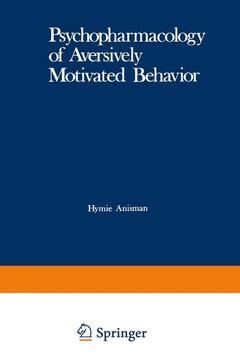Psychopharmacology of Aversively Motivated Behavior, Softcover reprint of the original 1st ed. 1978
Langue : Anglais
Coordonnateur : Anisman H.

During the past two decades, remarkable advances have been made in psychopharmacology, resulting in increased demands for journal space (witness the large number of journals that cater primarily or exclusively to this topic). Concomitantly, a need developed for more integration of the currently available data. To this end, numerous edited volumes in psycho pharmacology have appeared which have been primarily concerned with the role of a particular drug or system in modulating a wide variety of behaviors. While such texts have been most useful in elucidating drug mechanisms and the etiology of a number of behaviors, few attempts have been made to evaluate and integrate pharmacological treatments within a single behavioral category. Specifically, the researcher interested in understanding a given behavior from a neurochemical point of view must consult several texts, each dealing with a different chemical or system. When texts are obtained covering a broad spectrum of systems, they also invariably deal with many different behaviors, thus not allowing for complete integration within a behavioral category. The present volume was planned to meet the needs of the scientist interested in understanding neurochemical mechanisms underlying aversively motivated behavior, as well as drug effects thereon. In organizing the contents of this text, it quickly became apparent that any attempt to provide a complete overview of behavioral and pharmacological information pertaining to aversive situations was not practical for at least two reasons.
1 Aversively Motivated Behavior as a Tool in Psychopharmacologic Analysis.- I. Introduction.- II. Theoretical Models.- III. Components of Avoidance Behavior—Implications for Psychopharmacology.- IV. Strategies for the Assessment of Treatment Effects.- V. General Summary.- References.- 2 Behavioral Genetics and Animal Learning.- I. Introduction.- II. Basic Concepts and Methods.- III. Major Research Questions.- IV. Mendelian Inheritance, Pleiotropy, and Relations between Characters.- References.- 3 Neurochemical Changes Elicited by Stress: Behavioral Correlates.- I. Introduction.- II. Effects of Acute Stress on Levels and Turnover of NE, DA, and 5-HT.- III. Stress-Induced Increases in Amine Levels.- IV. Neurochemical Change and Coping Style.- V. Hormonal Changes after Stress.- VI. Genetic Factors.- VII. Stress-Induced Neurochemical Changes: Implications for Avoidance Behavior.- VIII. Implications for Human Behavior.- IX. Overview.- References.- 4 Cholinergic Mechanisms and Aversively Motivated Behaviors.- I. Introduction.- II. Selected Neurochemical Aspects of Cholinergic Drug Action.- III. Behavioral Effects of Muscarinic Agonists and Antagonists.- IV. Sites of Drug Action.- V. Nicotinic Stimulation and Blockade.- VI. General Conclusions.- References.- 5 Monoamines and Aversively Motivated Behaviors.- I. Introduction.- II. Neuropharmacology of the Monoamines.- III. Some Aspects of the Neuropharmacology of the Monamines.- IV. Catecholaminergic Mechanisms and Nonassociative Behavioral Change.- V. Catecholaminergic Mechanisms and Aversively Motivated Behaviors.- VI. Serotonergic Mechanisms and Aversively Motivated Behaviors.- VII. Conclusions.- References.- 6 Hallucinogens.- I. Introduction.- II. The General Pharmacology of Hallucinogens.- III. Effects of Hallucinogens onAnimal Behavior.- IV. Current Models and Hypotheses for the Effects of Hallucinogens.- V. Relevance to Human Effects.- VI. Conclusion.- References.- 7 Effects of Neuroleptics, Ethanol, Hypnotic-Sedatives, Tranquilizers, Narcotics, and Minor Stimulants in Aversive Paradigms.- I. Introduction.- II. Neuroleptics (Major Tranquilizers).- III. Ethanol, Hypnotic-Sedatives, and Minor Tranquilizers.- IV. Narcotic Agonists and Antagonists.- V. Miscellaneous Stimulants.- VI. Conclusions.- References.- 8 Stimulus Attributes of Drugs.- I. Drugs as Unconditioned Punishing Stimuli.- II. Drugs as Unconditioned Reinforcing Stimuli.- III. Drugs as Conditioned Stimuli.- IV. Summary.- References.- 9 A Comparative Neurochemical, Pharmacological, and Functional Analysis of Aversively Motivated Behaviors: Caveats and General Considerations.- I. Theoretical Frameworks for Aversively Motivated Behaviors.- II. Role of Neurochemical Activity in Aversive Situations.- III. Comparative Analysis of Selected Drug-Induced Syndromes.- IV. Relevance of Research on Infrahuman Subjects to Human Psychopharmacology.- V. Conclusions.- References.- Author Index.
Date de parution : 03-2012
Ouvrage de 564 p.
15.2x22.9 cm
Thèmes de Psychopharmacology of Aversively Motivated Behavior :
Mots-clés :
© 2024 LAVOISIER S.A.S.



